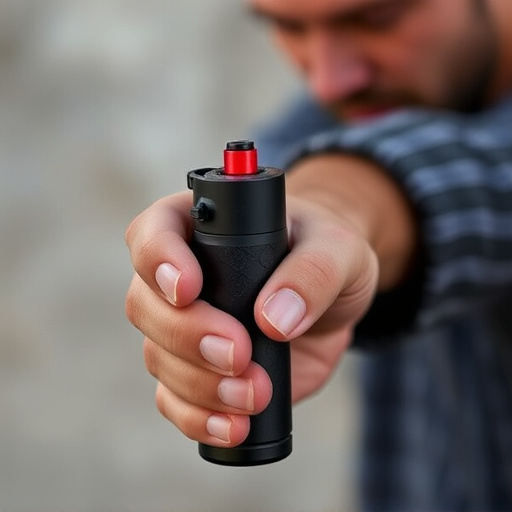Non-lethal self-defense tools have evolved with gel-based formulations (gel pepper spray) offering a safer, more strategic alternative to traditional aerosol sprays. Gel forms create thicker, stickier substances that adhere to attackers' bodies longer, maximizing impact. In contrast, aerosol sprays quickly disperse, providing temporary blindness but potentially not staying on the assailant long enough. Gel options offer localized defense, reducing accidental exposure risks and bystander contamination. While gel has advantages in close combat, traditional pepper spray's instant relief and powerful irritant make it suitable for wider areas and determined aggressors. The choice between gel and traditional depends on personal preference and tactical needs for self-protection.
“In the realm of personal safety, non-lethal inflammatory tools offer a crucial alternative to conventional firearms. Among these, gel and traditional pepper spray stand out as popular choices, each with distinct properties. This article navigates the ‘Gel vs Traditional Pepper Spray’ debate, providing an in-depth analysis of their key differences, advantages, and disadvantages. By understanding these factors, you can make an informed decision and choose the ideal self-defense tool tailored to your needs.”
- Understanding Non-Lethal Inflammatory Self-Defense Tools
- Gel vs Traditional Pepper Spray: Key Differences
- Advantages and Disadvantages of Each Option
- Choosing the Right Self-Defense Tool for Your Needs
Understanding Non-Lethal Inflammatory Self-Defense Tools
Non-lethal inflammatory self-defense tools have gained significant attention as an alternative to traditional pepper spray, offering a safer and more strategic option for personal protection. These innovative devices utilize various compounds to induce temporary disorientation or pain without causing serious harm. One prominent distinction lies between gel-based formulations and conventional aerosol sprays. Gel forms, often referred to as “gel pepper spray,” provide a thicker, stickier substance that can adhere to attackers’ eyes, skin, and clothing, prolonging the effects and ensuring better retention on surfaces.
In contrast, traditional pepper spray uses a fine aerosol mist, which quickly disperses into the air upon activation. While effective in creating temporary blindness and breathing difficulties, it may not always stay in contact with the assailant’s body long enough to maximize its impact. Gel-based options represent a step forward in self-defense technology, offering a more persistent and powerful defense mechanism against potential threats.
Gel vs Traditional Pepper Spray: Key Differences
In the realm of non-lethal self-defense tools, gel and traditional pepper spray represent two distinct options with unique characteristics. Gel formulations offer a growing trend in personal safety products, setting them apart from conventional aerosol-based pepper sprays. One key difference lies in their application methods; gels are typically applied with a direct touch, allowing for more targeted use and potentially reducing the risk of accidental exposure. This precision can be advantageous in close-quarters combat or when aiming to disable an attacker without causing prolonged blindness.
Conversely, traditional pepper spray relies on aerosolization to deliver its active ingredient, capsaicin, into the eyes and respiratory system of the target. While effective at creating a temporary disability, it may result in wider area contamination, including potential harm to bystanders if not used responsibly. Gel formulations address this concern by offering a more localized defense, making them appealing for those seeking non-lethal yet potent self-defense mechanisms tailored to specific scenarios.
Advantages and Disadvantages of Each Option
In the realm of non-lethal self-defense tools, Gel and Traditional Pepper Spray stand out as popular choices. Each option offers distinct advantages and disadvantages that cater to various user preferences and tactical needs.
Gel-based self-defense products have gained traction due to their unique properties. They often provide a longer lasting sensation, making them effective against multiple aggressors. This gel formula can also adhere to skin and clothing, ensuring prolonged irritation and disorientation of the attacker. However, application may be more challenging in certain situations, especially when quick reflexes are required. On the other hand, Traditional Pepper Spray remains a classic favorite for its immediate impact. It offers a swift and powerful irritant that temporarily blinds and disorients an assailant. Easy to use and carry, pepper spray is readily available and has been relied upon by law enforcement and civilians alike for years. Yet, wind conditions can affect its effectiveness, and the range may be more limited compared to gel-based options.
Choosing the Right Self-Defense Tool for Your Needs
When selecting a self-defense tool, understanding your specific needs is crucial. One popular option to consider is non-lethal inflammatory agents, particularly gel and traditional pepper spray. These tools offer a range of benefits for personal safety. For instance, pepper spray is a well-known and widely used option, creating temporary blindness and respiratory distress in the target, allowing you to escape safely.
However, gel-based self-defense options have gained attention due to their unique properties. Gels are often more concentrated and can provide a longer-lasting effect, offering an extra layer of protection. The distinction between gel and traditional pepper spray lies in application and duration; gels may offer a more targeted and prolonged reaction, which could be advantageous in certain situations. This consideration is key when deciding between these non-lethal options, ensuring you choose what best suits your personal safety requirements.
In the quest for effective personal defense, understanding the nuances between gel and traditional pepper spray is paramount. Both offer unique advantages in non-lethal inflammatory self-defense tools, but each has its drawbacks. Gel sprays provide a longer range and less offensive smell, while traditional pepper spray offers faster activation and higher effectiveness close-up. Ultimately, choosing between them depends on individual needs and preferences, ensuring you’re prepared for any situation. Remember, the right self-defense tool can be a game-changer in potentially dangerous scenarios, so consider your environment, comfort level, and the specific Gel Vs Traditional Pepper Spray dynamics before making your decision.
